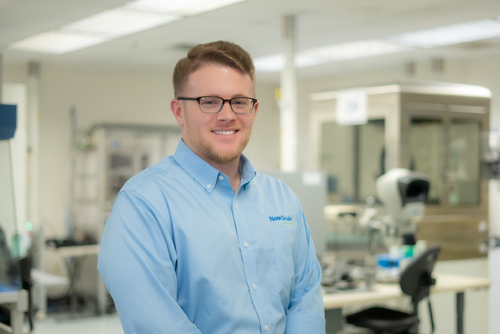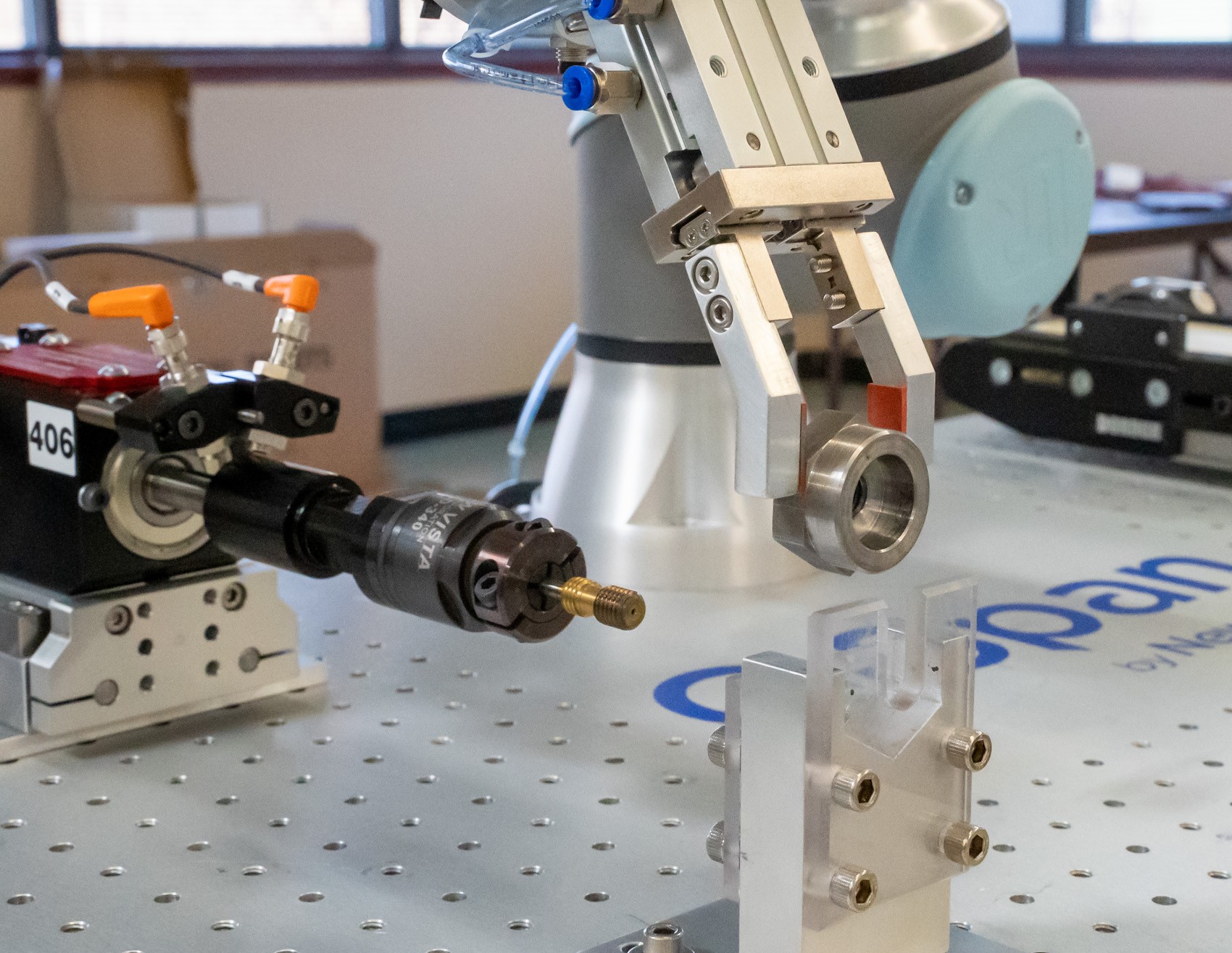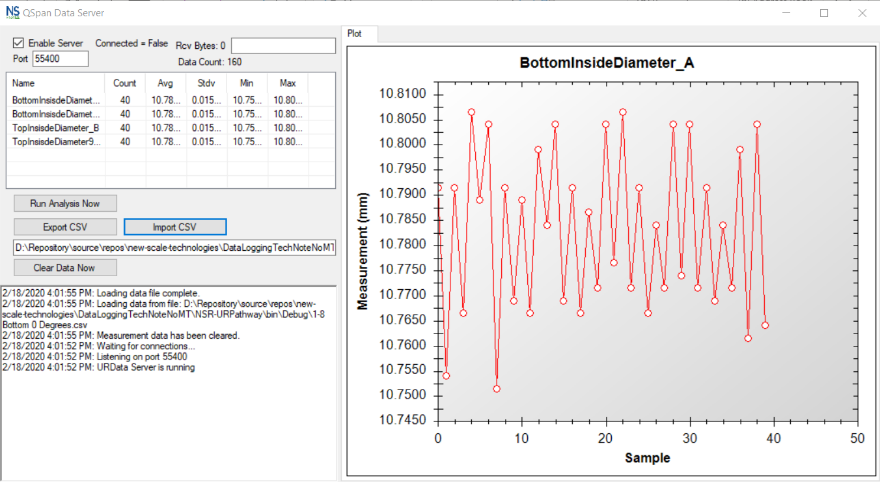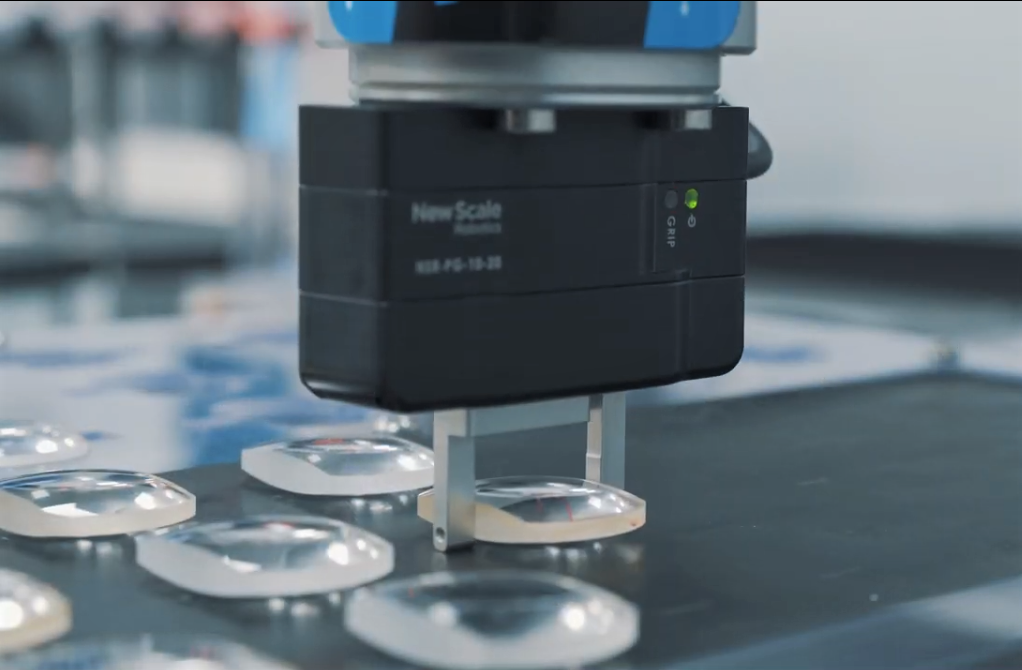Premium partners help New Scale Robotics deliver premium gauging systems, perfectly tailored to your application and ready to expand
An advantage of collaborative robots (cobots) is the robust ecosystem of end-of-arm-tooling, sensing, and other components that interface with cobots. The built-in emphasis on plug-and-play usability supports fast configuration and flexible automation.
The range of choices for these components can seem daunting at first. But once you understand the application, the choices become clearer. Here’s how we use our understanding of the gauging application, and our partnerships within the cobot and gauging ecosystems, to make choices when we configure a Q-Span Gauging System for a customer.
Breaking it down
We start by bringing the customer’s part print and description of their manual gauging process to our engineering team. We usually break down the project into the basic process steps: pick, measure, record, and place. For each of these process steps we consider cycle time, duty cycle, reliability, gauge repeatability, ease of use, digital connectivity, and other factors important to the use case.

by Stefan Friedrich, Marketing Manager, New Scale Robotics
Pick
Grippers are ubiquitous in the industrial automation world. You need only do a web search for “gripper” to find hundreds, if not thousands, of different options including electric, pneumatic, and vacuum grippers. We start by considering the part’s size and weight, the location on the part to be gripped, and the part’s surface. Then we look at considerations such as gripping force and precision needed. We default to our own parallel electric gripper/caliper due to its precision and flexibility. We then consider premium brands, like Schunk, known for their reliability and numerous options.
Part pickup location and orientation is the next challenge. The simplest solution is to use basic part trays or conveyors, such as Dorner conveyors, that present parts in a consistent location and orientation.
Things get more complicated when you need to clean parts or pick them from random orientations. A vibration table is a common feeding option. Asyril’s Asycube vibration feeding system includes a machine vision system based on Artificial Intelligence (AI) that can send part coordinates to the robot. With an easy-to-use software package, you can teach the robot to pick parts with random orientations. The Asycube feeder particularly shines in a high-mix, low-volume manufacturing environment. For example, we deployed a system that used an Asycube feeder for more than a dozen unique parts with different shapes and sizes.
Other bin picking solutions include ActiNav from Universal Robots, Apera AI, and PickIt 3D.
We often work in shop-floor environments next to CNC machines. Cleaning parts after machining, prior to presenting them to a metrology system, is a must! You should not be gunking up your gauges with residual oil or coolant. We like MiJet’s range of blow-off stations and other part cleaning solutions that help make parts “chipless and dripless” before they get to the metrology equipment.
Measure
Measurement systems fall into two categories: contact and non-contact inspection systems.
We strive to emulate the manual gauging process that our customers are currently using and have already validated. This eases the validation studies required to deploy the automated system in the plant. Using a manual caliper? Use a robotic caliper. Using a thread gauge? Use a motorized thread gauge. Using a laser micrometer? I think you get the point…
Contact gauging instruments such as linear probes, automated thread gauges, bore gauges, surface finish systems, and more can be incorporated into a Q-Span workstation, as long as we can communicate with it via the UR robot controller or a PLC. Market leaders like Keyence have amazing off-the-shelf interfaces and I4.0 capabilities. We can work with your preferred gauge provider, such as leading gauging providers like Marposs, Mahr, and Mitutoyo.
Non-contact gauging methods such as machine vision have many benefits, including speed, accuracy, and digital connectivity. They can be complex to automate. Lighting, programming, and cost are usually limiting factors. To be honest, we tend to avoid vision-based measurement systems when possible, as they typically do not meet our bar for customer ease of use. When we deploy a Q-Span gauging system, we train our customers to use these systems as a tool on their own shop floor, ideally teaching them how to use and redeploy the system for new parts in the future.
Fixed non-contact systems, like a laser micrometers (Keyence) or air gauges (Western Gage or Air Gaging LLC), are simpler to automate because there is usually only one measurement and variable to factor into the process flow. These tools have been successfully incorporated into Q-Span Systems.

A pneumatic gripper placing a part into a fixture for gauging using a motorized thread gauge
Record
We record our measurement data in a basic ASCII format. By default, we export data in CSV or Excel format via our data server. Optionally, we can format the data for export to SPC software like InfinityQS, Minitab SPC, or Prolink.
Machine shops frequently use data from the Q-Span System to monitor machine tool wear during manufacturing. Q-Span Gauging Systems can enable a closed-loop machining and inspection process when used in concert with automated tool wear compensation software from providers like Caron Engineering or Flexxbotics. As machine shops work to run more machines while shorthanded, or move towards lights-out production, this kind of live feedback is increasingly in demand.

Data logging screen from the Q-Span Workstation
Place
This is usually the easy part. We’ve gotten this far with picking, cleaning, measuring, and recording data, and our work is about done. We often just drop the parts into a bin, organize them into pass/fail trays, or sort them based on size.
If we need to connect with another robot, load a conveyor, or coordinate with another machine or automated system, that can certainly add some complexity. But since we already have the part in our gripper, in a known orientation, and we know if the part is good or bad, the decision-making is quite simple.

Placing a lens on a simple output tray
Complete Automated Gauging systems
The core of the Q-Span System is the cobot by Universal Robots. We chose to partner with UR because of their position as the market leader in cobots, extremely easy-to-use interfaces, and emphasis on building an ecosystem with hundreds of plug-and-play products for manufacturing users.
Our partnerships enable us to quickly configure and deploy the right automated gauging system for each customer.

